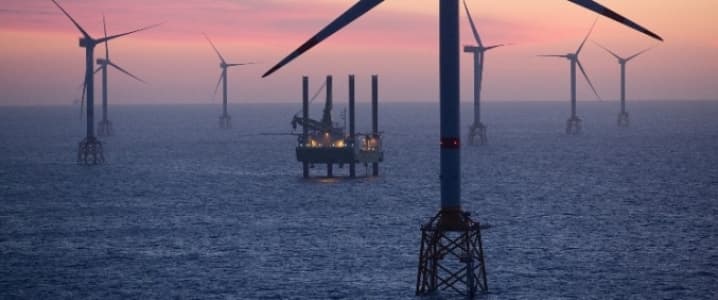Wind power has now overtaken hydroelectric as the largest single source of clean energy in the United States. With 82 thousand MWs of total installed capacity at the end of 2016, wind turbines exceeded the 80 thousand MWs generated by the nation’s hydroelectric dams. This comes on the heels of the EIA’s short-term energy outlook which predicts wind and solar power will continue to account for the fastest growth in the U.S. energy sector, repeating a trend from last year. The EIA predicts wind power will reach 94 thousand MWs by 2018.
Wind hasn’t surpassed hydroelectric power in all categories, however; in terms of actual power generated, dams still out-perform wind turbines, as they tend to stay on for more of the year. But with few dams planned for construction, it’s likely wind power will exceed hydroelectric in actual power produced in the next few years.
The American Wind Energy Association (AWEA) has reported that 10 thousand MWs in new power is currently under construction, including the Amazon Wind Farm off the coast of Elizabeth City, NC, the nation’s first large off-shore wind farm. Last year, 8200 MWs was added, most of it in the year’s final quarter.
Much of the growth is being driven by Texas, by far the country’s largest producer of wind power and the industry’s leader in adding new capacity. Texas produces 20 thousand MWs, around a quarter of the national total, and maintains more than 11 thousand turbines, which produce 13 percent of the state’s total power. Texan interest in wind power, which grew under Governor Rick Perry, has wind energy advocates hopeful that Perry’s current role as Secretary of Energy won’t prove an impediment to additional growth. Related: Oilfield Services Rush To Raise Capital As Oil Recovery Holds
Further interest in wind power may be generated by the sector’s growing role as a job creator. Wind power provides employment for about 100,000 people nationwide, far more than the coal industry. Bloomberg has reported that wind power advocates and developers have been urging the federal government, which has shown considerable interest in rejuvenating the U.S. coal industry, to instead shift their attention to wind power.
Much of the sector’s growing capacity is coming in rural areas, chiefly in the Midwest. North Dakota, to name one example, has seen 3 thousand MWs installed in the past decade, and one-third of that total in just the last 10 months.
Internationally, the U.S. remains way behind China in terms of wind power capacity. Of the 54 GW installed worldwide in 2016, China accounted for 42 percent, or 23.3 GW. According to Chinese projections, by 2030 wind turbines will supply 26 percent of total electricity demand. China cannot produce electricity with the same efficiency as American turbines, according to Bloomberg, chiefly due to inadequate transmission lines. Related: The Oil Majors To Watch In A Trump Threatened Iran
In Europe, another leader in wind power, 12.5 GW was added, a slight decrease from 2015.
Since the U.S. election last year, the big question facing renewable energy is whether the new Trump Administration, outwardly hostile to non-fossil fuels and critical of climate change advocacy, will prove a hindrance to growth in their sector. Some investors are optimistic, confident that the plummeting cost of wind turbines, the attraction of constructing new wind farms in rural or low-income areas, and the strong demand will continue to propel growth. As one advocate for wind power noted in the Dallas Morning News, “88 percent of wind capacity installed…was in states that voted for Trump.”
Wind power has attracted strong interest from major U.S. corporations. Google is backing a plan to build a 225 MW wind farm in Oklahoma, bringing the company’s renewable energy portfolio to 2.6 GW. Amazon is constructing turbines in North Carolina to power a server facility. The GM factory in Arlington, TX receives half its power from wind turbines, and plans are set for that figure to reach 100 percent by 2018. The car manufacturer announced plans last November to power fifteen of its factories with wind power and plans on meeting all of its energy needs with renewables by 2050.
The announcement of New York’s planned 90 MW off-shore wind farm offers further indications of potential growth in the wind power sector. Despite the potential obstacles, economic and political, wind power will continue to be an attractive option for adding new electricity capacity.
ADVERTISEMENT
By Gregory Brew for Oilprice.com
More Top Reads From Oilprice.com:
- Qatar Petroleum Continues To Climb Past The Oil Majors
- Mafia, Guns And Clans: The Big Libyan Oil Heist
- OPEC Reports First Output Deal Results: 890,000 Bpd Cut



















Moreover, both are critical for water. Wind offsets thermal generation which taps water resources, while hydro manages those resource. Water is better used for agriculture and human consumption than consumed for energy production. Now with the Oroville Dam compromised water resources in California will continue to be strained even past the drought.
It produces little power at high cost, without all the subsidy's and fake numbers, it would fail under economics 101. It also sucks the life out of countries. What drives an economy is cheep energy. Factories will fail if they are paying 90c and the neighbor only pays 5c for electricity.
No one wants them, outside government. Go to any rural area, where they are installing them, and you will find massive opposition to them. The only way they can be installed these days, is with a government, that no longer cares what you think or say.
Then, of course, is the fact that they kill millions of birds and bats, and have to be exempted from rules about killing eagles and other threatened species. They have been aptly called bird Cuisinarts. All this to provide high cost, unreliable power which requires 100% conventional power backup for when the wind doesn't blow. This only makes sense to those steeped in the green religion who don't live under these monstrosities.